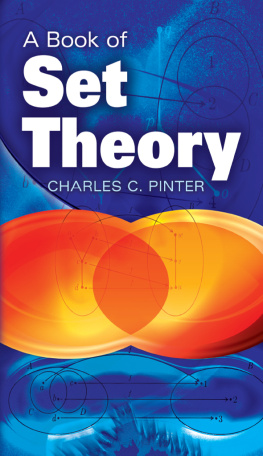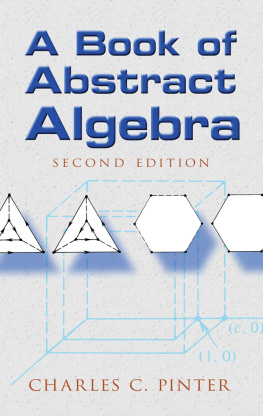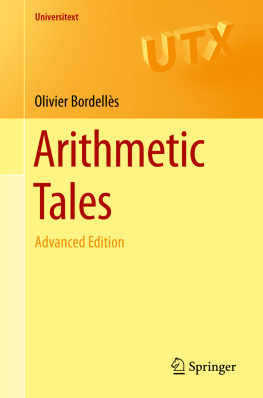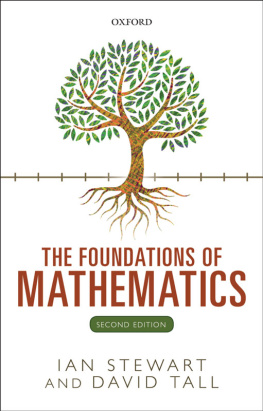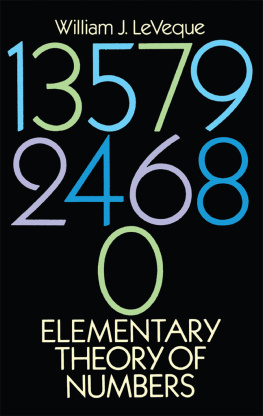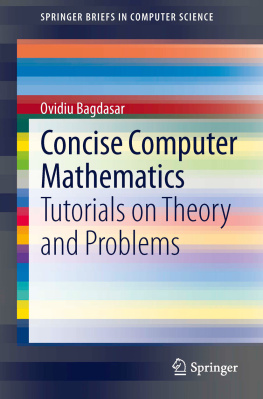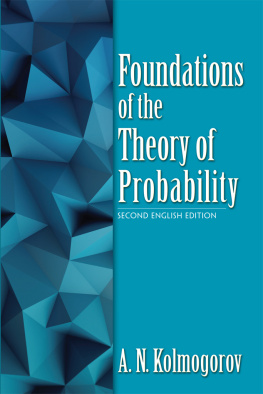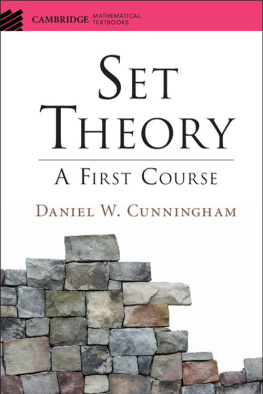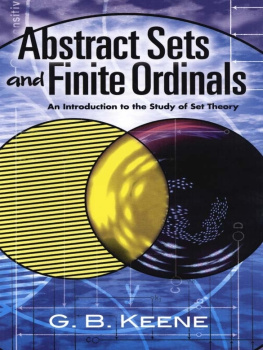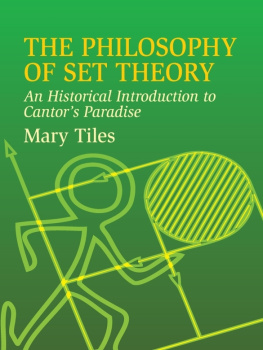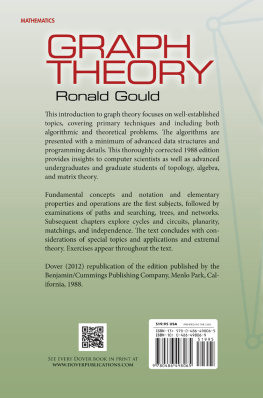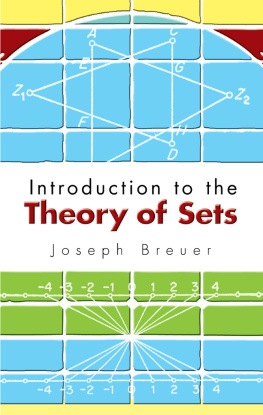A Book of
SET THEORY
CHARLES C. PINTER
Emeritus Professor
Bucknell University
DOVER PUBLICATIONS, INC.
Mineola, New York
Copyright
Copyright 1971, 2014 by Charles C. Pinter
All rights reserved.
Bibliographical Note
A Book of Set Theory, first published by Dover Publications, Inc., in 2014, is a revised and corrected republication of Set Theory, originally published in 1971 by Addison-Wesley Publishing Company, Reading, Massachusetts. This book has been reprinted with the cooperation of Kyung Moon Publishers, South Korea.
Library of Congress Cataloging-in-Publication Data
Pinter, Charles C., 1932author.
A book of set theory / Charles C Pinter.
p. cm.
A revised and corrected republication of Set Theory, originally published in 1971 by Addison-Wesley Publishing Company, Reading, Massachusetts.
Summary: This accessible approach to set theory for upper-level undergraduates poses rigorous but simple arguments. Each definition is accompanied by commentary that motivates and explains new concepts. A historical introduction is followed by discussions of classes and sets, functions, natural and cardinal numbers, the arithmetic of ordinal numbers, and related topics. 1971 edition with new material by the authorProvided by publisher.
Includes bibliographical references and index.
eISBN-13: 978-0-486-79549-2
1. Set theory. I. Title.
QA248.P55 2013
511.3.22dc23
2013024319
Manufactured in the United States by Courier Corporation
49708901 2014
www.doverpublications.com
To my students,
from whom I have learned how to explain and how to teach
Contents
Preface
Over many years of selecting instructional materials for my courses, I came to understand that textbooks that are congenial to students obey a law of reciprocity that I wish to propose as an axiom:
Axiom The more effort an author puts into writing a text, the less effort is required of the reader to understand it.
I adopted this guiding principle as a categorical imperative during the writing of this book. Even after all the mathematics was in place, I reread and rewrote many times and tested explanatory strategies with my students. I have dedicated this book to them because they have been my most patient and honest critics. The book owes its present form largely to them and to their (sometimes nave, often brilliant) suggestions.
Mathematics has a superbly efficient language by means of which vast amounts of information can be elegantly expressed in a few formal definitions and theorems. It is remarkable that the life work of consecutive generations of great thinkers can often be summed up in a set of equations. The economy of the language masks the richness and complexity of the thoughts that lie behind the symbols. Every mathematics student has to master the conventions for using its language effectively. However, what is far more important is that the student be initiated into the inner life of mathematicsthe images, the intuitions, the metaphors that, once grasped, make us say, Aha! Now I understand! Now I see it! This inner seeing is what makes mathematics vital and exciting.
What is most unique about set theory is that it is the perfect amalgam of the visual and the abstract. The notions of set theory, and the ideas behind many of the proofs, present themselves to the inner eye in vivid detail. These pictures are not as overtly visual as those of geometry or calculus. You dont see them in the same way that you see a circle or a tangent line. But these images are the way into abstraction. For the maturing student, the journey deeper into abstraction is a rite of passage into the heart of mathematics.
Set theory is also the most philosophical of all disciplines in mathematics. Questions are bound to come up in any set theory course that cannot be answered mathematically, for example with a formal proof. The big questions cannot be dodged, and students will not brook a flippant or easy answer. Is the continuum hypothesis a fact of the world? Is the axiom of choice a truth? If we cannot answer with a definite yes or no, in what manner are they justified? (That one requires a long answer). What is the meaning of the Jacobs ladder of successive infinities so high that the very thought of it leads to a kind of intellectual vertigo? To what extent does mathematics dwell in a Platonic realmand if it does, then in the words of Eugene Wigner, how do you explain the unreasonable effectiveness of mathematics in the natural world? Or as Descartes wondered, where do you find the nexus between the material world and the products of thought?
In this book I have tried, insofar as possible, not to evade these questions nor to dwell on them excessively. Students should perceive that mathematics opens doors to far-reaching and fascinating questions, but on the other hand they must remain anchored in mathematics and not get lost in the narcotic haze of speculative thought. I have tried to provide the necessary background for understanding axiomatics and the purpose and meaning of each of the axioms needed to found set theory. I have tried to give a fair account of the philosophical problems that lie at the center of the formal treatment of infinities and other abstractions. Above all, of course, I have endeavored to present the standard topics of set theory with uncompromising rigor and precision, and made it clear that the formalism on the one hand, and the intuitive explanations on the other hand, belong in two separate domains, one useful for understanding, the other essential for doing mathematics.
This book is a revised and re-written version of an earlier edition, published in 1972 by Addison-Wesley. I have retained most of the formal definitions, theorems and proofs, with nothing more than a few corrections where needed. I have also retained the initial chapter that narrates the origins and early history of set theory, because history (in general) does not change. I have added commentary, introduced some new discussions, and reorganized a few proofs in order to make them cleaner and clearer. Finally, I have added a new chapter on models of set theory and the independence results of Gdel and Cohen. I have set the discussion of these topics at a level that is accessible to undergraduates while not concealing the difficulties of the subject.
Historical Introduction
1 THE BACKGROUND OF SET THEORY
Although set theory is recognized to be the cornerstone of the new mathematics, there is nothing essentially new in the intuitive idea of a set. From the earliest times, mathematicians have been led to consider sets of objects of one kind or another, and the elementary notions of modern set theory are implicit in a great many classical arguments. However, it was not until the latter part of the nineteenth century, in the work of Georg Cantor (18451918), that sets came into their own as the principal object of a mathematical theory.
Strangely, it was his work in the highly technical field of trigonometric series which first led Cantor to study the properties of sets. At first, he confined himself to certain particular sets of real numbers which occurred in connection with the convergence of series. But Cantor was quick to understand that his discoveries applied to sets quite generally; in a series of remarkable papers, published between 1873 and 1897, he moved progressively further from the concrete problems which had initiated his thinking on sets, and toward the powerful general concepts which underlie set theory today.
The boldest step which Cantor had takenin the eyes of his contemporarieswas his use of infinite sets, which he considered as no less natural than using finite sets. The question of infinity had long been one of the most sensitive problems of mathematics. The reader is undoubtedly acquainted with Zenos famous paradox, in which a unit line segment is divided into subintervals by the points 1/2, 1/4, 1/8, 1/16, etc. Each subintervalno matter how smallhas a definite, nonzero length, and there are infinitely many subintervals; hence, the seemingly paradoxical conclusion that infinitely many nonzero lengths can be added together to produce a finite length. In order to avoid such traps, classical mathematicians made a distinction between the actual infinitein which infinitely many objects are conceived of as existing simultaneouslyand the virtual infinite, which is simply the potential to exceed any given finite quantity. The virtual infinite was regarded as safe, hence admissible, whereas the actual infinite was taboo.
Next page
